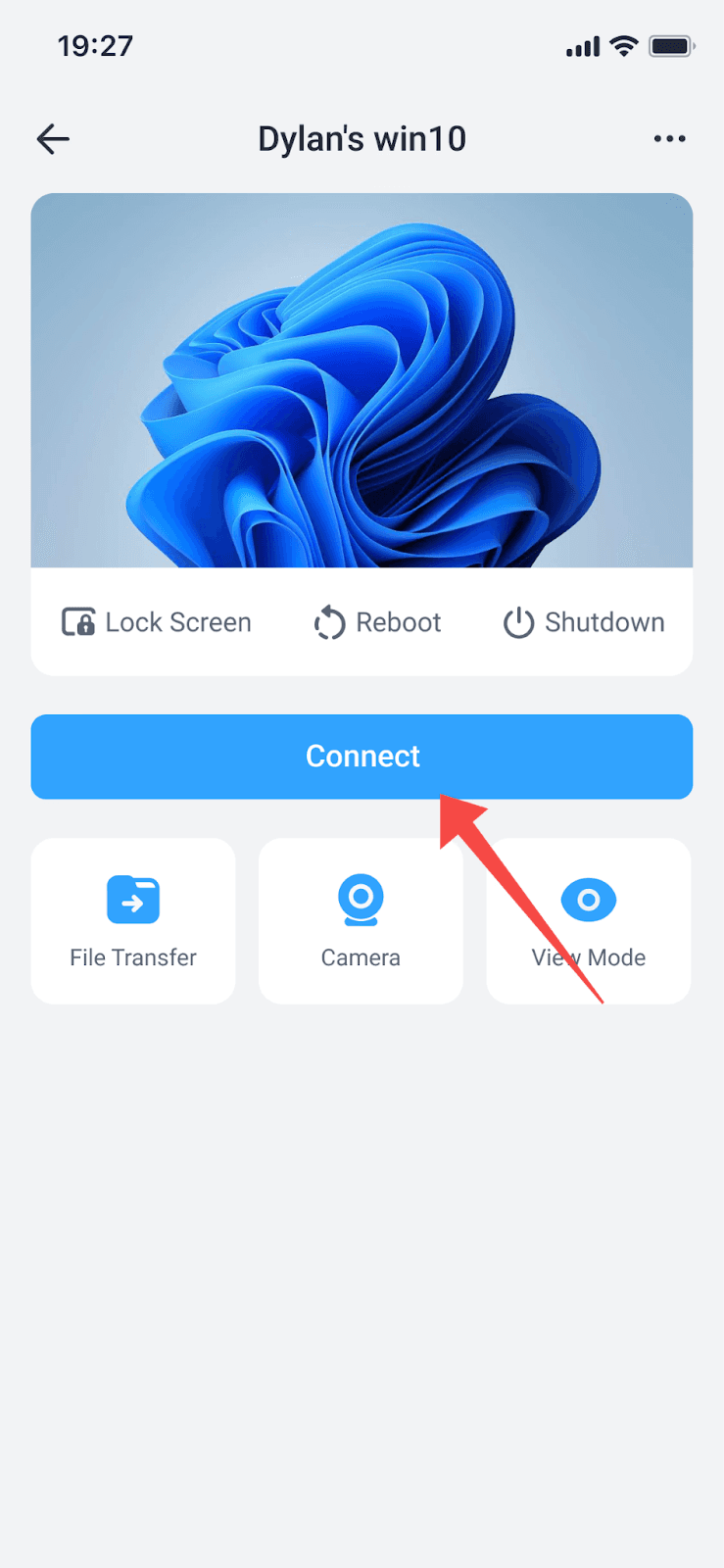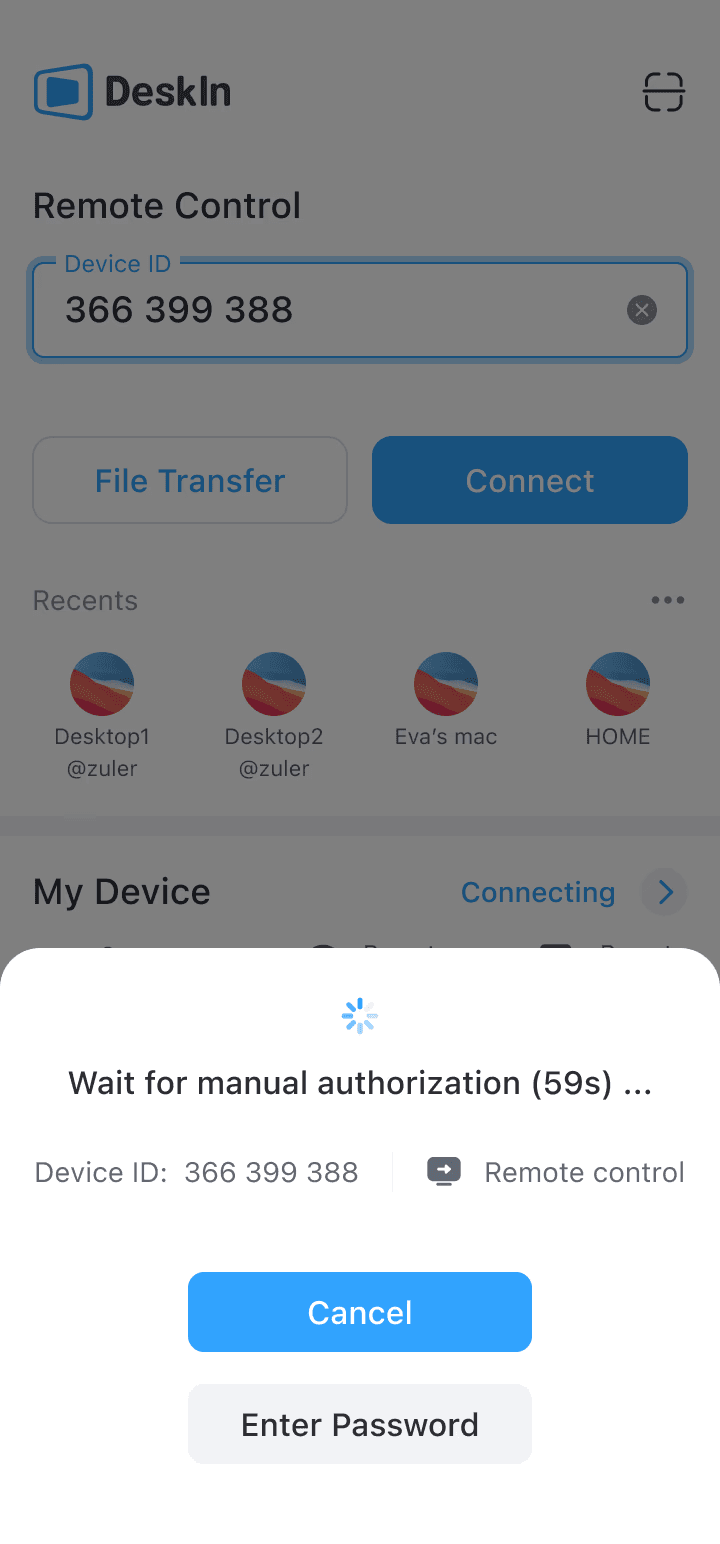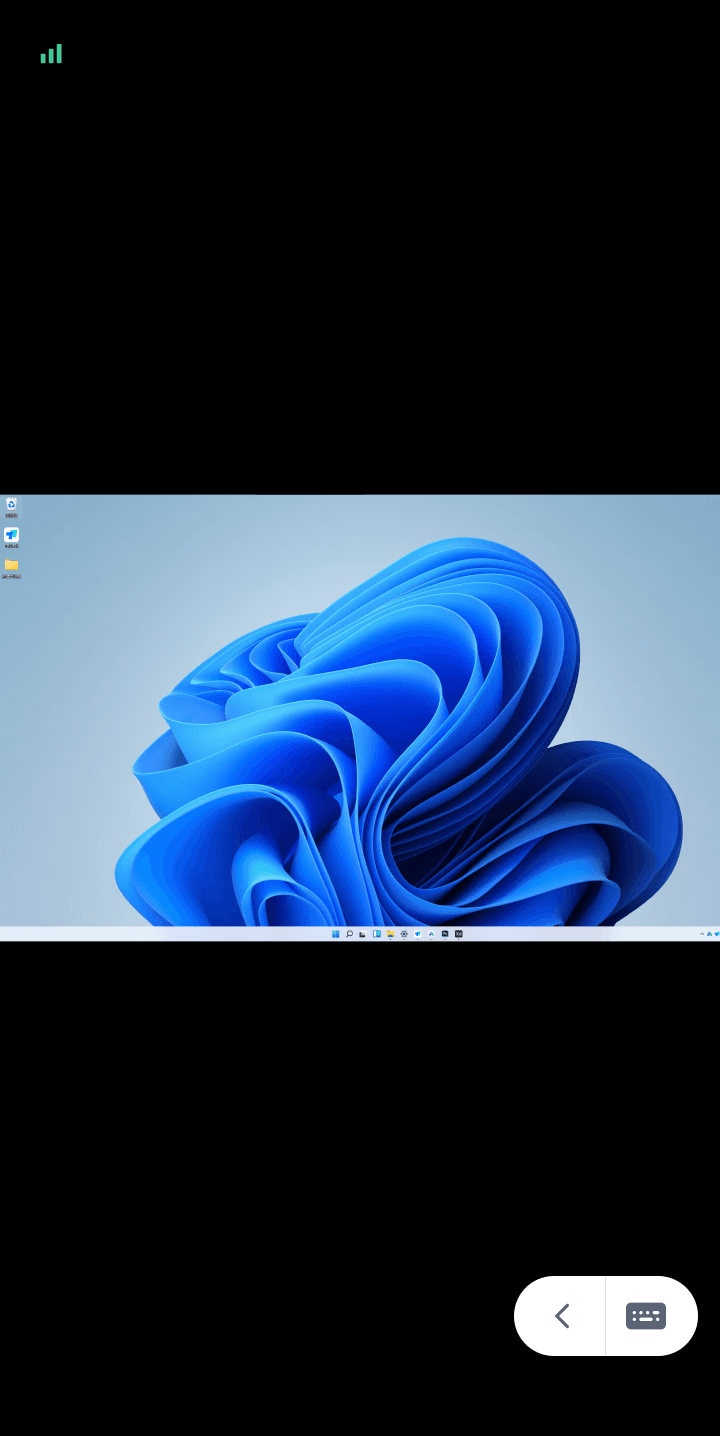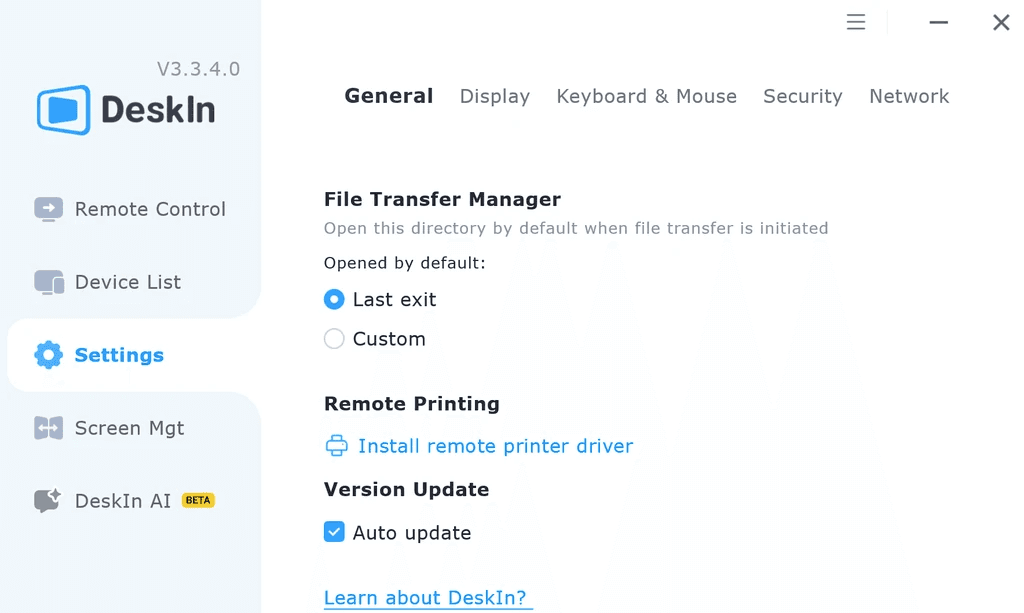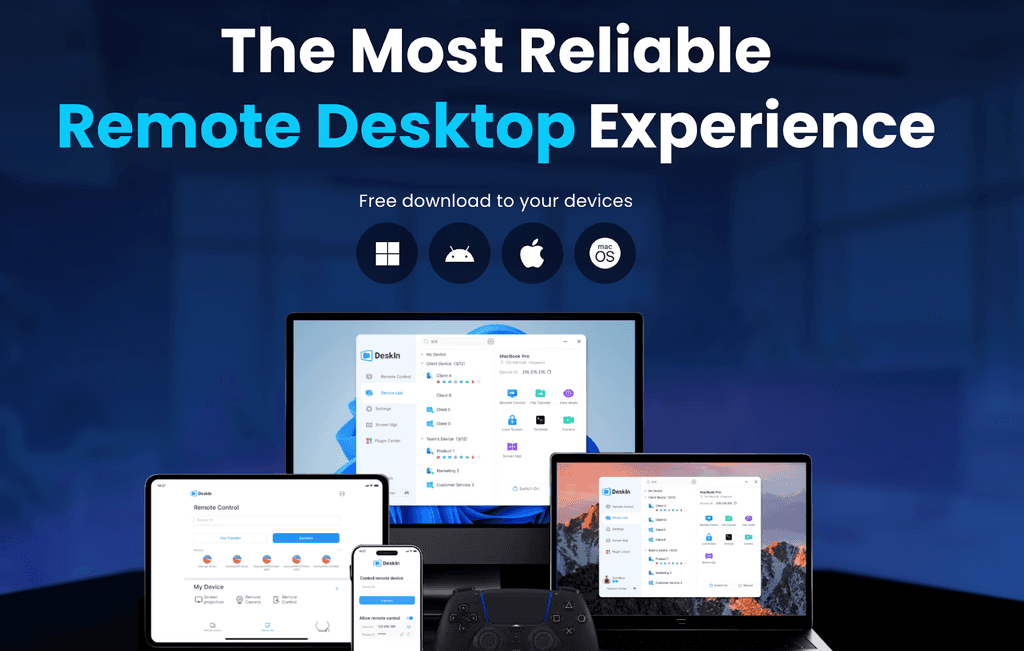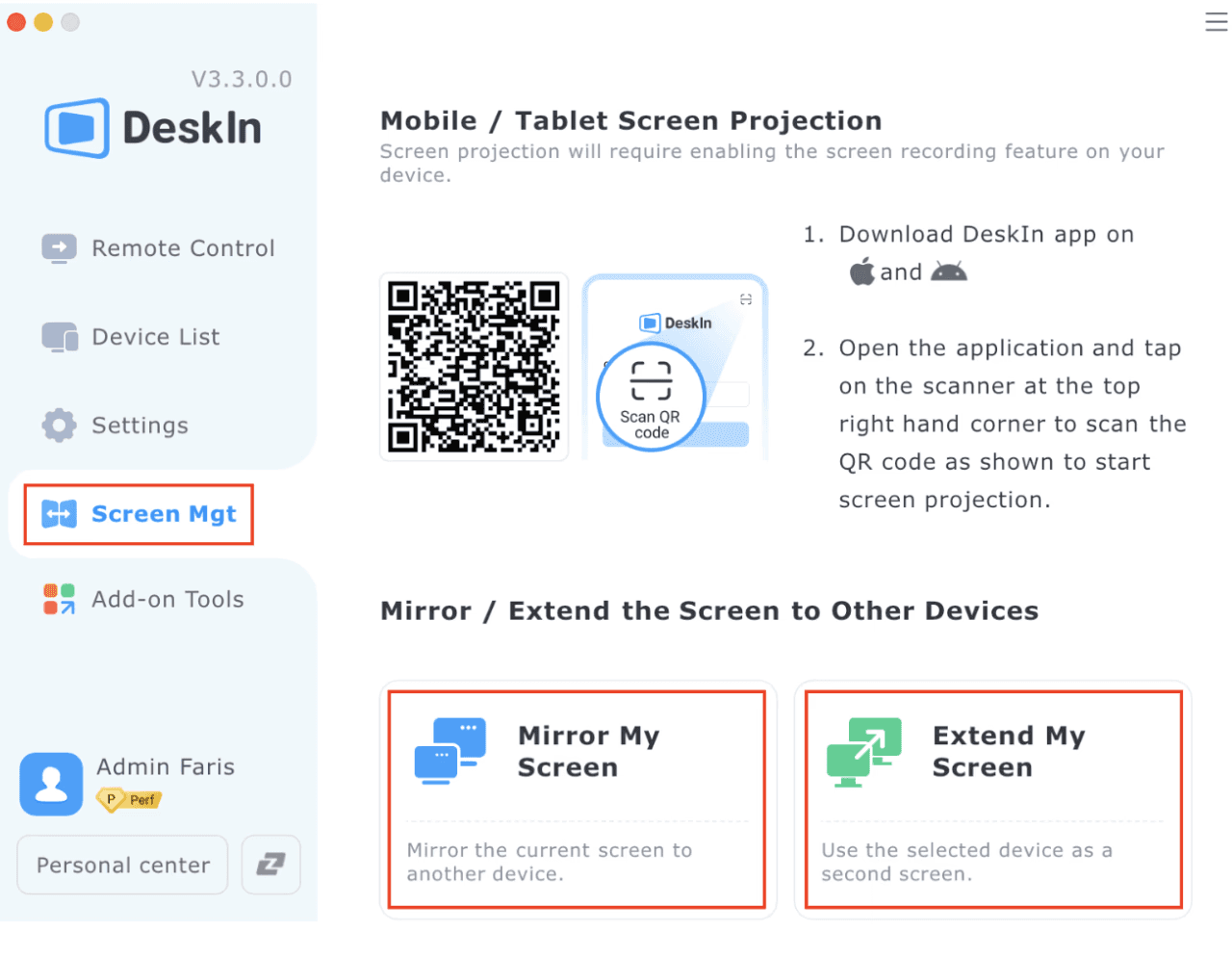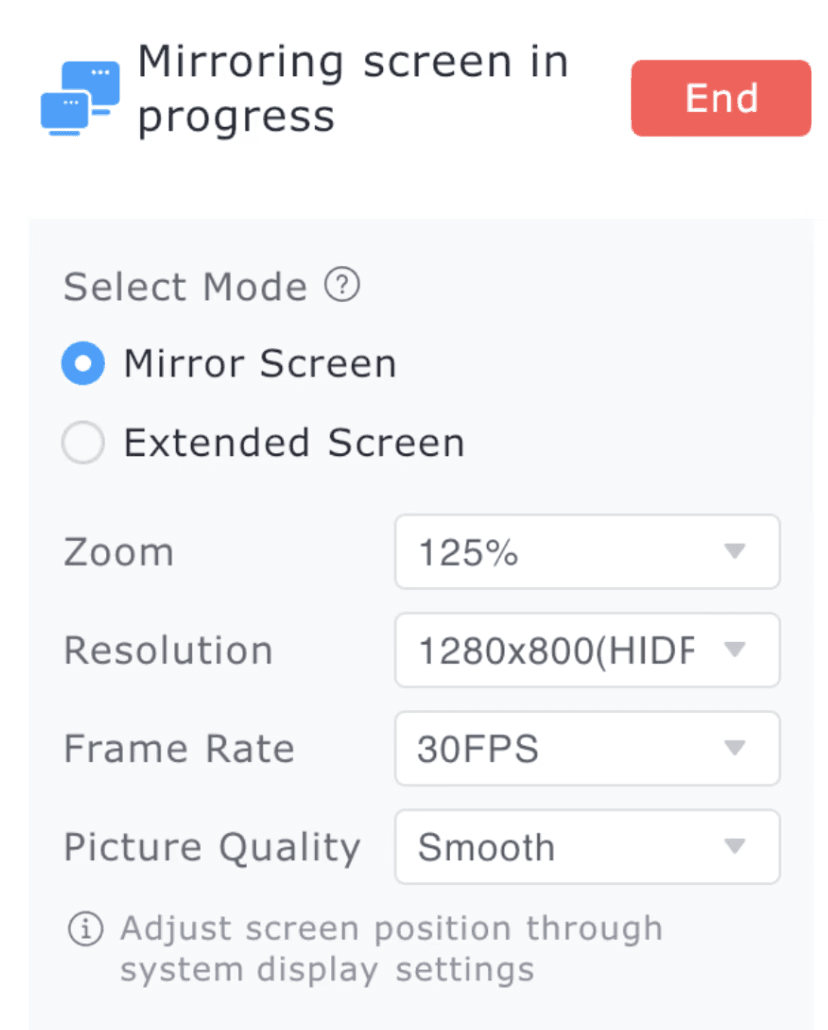更大的螢幕可以帶來更好的觀賞體驗,無論是工作匯報時共享檔案,還是在大螢幕上和家人朋友一起看電影或是旅行的相片,鏡像投影功能都能給我們帶來極大的便利。將螢幕串聯起來,讓我們之間的距離更近。對於蘋果使用者,要怎樣將iPhone或iPad的螢幕投影到MacBook呢?本文將提供三個簡單又實用的方法,並附有步驟指引,其中一個還適用於遠端投影,一起看看吧。
本文將提供三個簡單又實用的方法,並附有步驟指引,幫助您立刻輕鬆將 iPhone 連接到 Mac 進行螢幕鏡像,其中一個還適用於遠端投影,一起看看吧。
極速投影:使用 DeskIn 實現無線投影 iPhone/iPad 畫面
DeskIn 是一款適用於iOS、安卓、Mac 以及Windows使用的的遠端桌面應用程序,提供遠端連線、螢幕投影,螢幕擴充,生成虛擬螢幕等服務。在投影 iPhone 到 Mac 時,DeskIn 支援無線投影,擺脫 QuickTime Player 有線的束縛與距離限制,讓您在同一個空間內,或透過網路進行遠距投影,都能輕鬆投影。
在投影時,DeskIn 呈現清晰細膩的畫質。無論是分享高解析度的照片與影片,或是在會議中瀏覽文件細節,都能確保內容精準呈現。其出色的低延遲技術(低於40ms),讓您的手機操作能幾乎同步反應在電腦螢幕上,操作過程無比順暢。
優點:
輕鬆實現會議室電腦内無線鏡像,外地遠端鏡像 iPhone 畫面,在 Windows、Mac、iOS 與 Android 等不同裝置間實現跨平台鏡像。
保障高清畫質與超低延遲的傳輸。無論是分享照片細節、播放動態影片,還是進行線上演示,確保您獲得穩定不卡頓、操作即時同步的流暢體驗。
提供多種功能,除了設備投影,還能透過 iPhone 控制 MacBook 傳輸檔案,能用手機直接存取電腦裡的檔案,遠端工作更加方便。
步驟一:安裝並注冊帳號
首先需要在iPhone/iPad以及MacBook上下載安裝DeskIn軟體,注冊一個免費賬戶並登入。
注意:如果你是首次在新裝置上登入,需要到注冊信箱完成驗證,更好的保障帳戶安全。

步驟二:掃 QR Code 進行將 iPhone 鏡像到 Mac
打開MacBook上的DeskIn,點擊側邊欄「鏡像屏/擴展屏」。

打開iPhone或是iPad上的DeskIn,點擊右上角掃碼按鈕,掃描Macbook螢幕上的投影QR Code,點擊「開始投影」即可。

步驟三:開始投影,在 MacBook 上無縫觀看手機畫面
注意:步驟三和步驟二任選其一即可完成投影
打開iPhone/iPad的DeskIn,點擊「遠端控制」>>開啓「允許連缐本設備」選項 >> 點擊「手機投影」 >> 此時iPhone/iPad會出現「螢幕直播」提醒,點擊「開始直播」即可。
這時再在MacBook打開DeskIn,在設備列表裡選擇要鏡像的iPhone,點擊「觀看模式」,連線成功後就可以看到iPhone/iPad的鏡像畫面。此方式也適用於行動裝置和電腦不在同一地方,需要遠端進行投影的狀況。

更多閲讀:
經典內建:透過 QuickTime Player 有線投影iPhone/iPad 到電腦
除了使用 DeskIn 無線投影的方法,你還可以透過有線方式將 iPhone 或 iPad 的螢幕投影到 Mac 上,使用 macOS 系統內建的 QuickTime Player 就是一個最直接、穩定的選擇。這個方法特別適合需要低延遲、高畫質,且不希望受到網路環境干擾的關鍵場景,例如重要的會議簡報,或是需要高品質錄製手機操作畫面。
優點:
1.MacOS自帶的應用程序,不用下載額外軟體
2.使用USB連接,不需要依賴同一個WIFI網絡,影像品質高,無延遲
局限:
需要用到USB數據線連接iPhone/iPad和Macbook,不能做到無線鏡像
步驟一:連接裝置
使用 USB 線將你的iPhone 或 iPad連接到 MacBook。
步驟二:完成QuickTime Player設定
1、在 MacBook上打開 QuickTime Player,可以透過搜尋功能找到它。

2、在Macbook頂部工具列,找到QuickTime Player的工具列,選擇「檔案」> >「新建影片錄製」。

3.在錄製窗口中,點擊錄製按鈕旁邊的下拉箭頭,在下拉裝置列表中找到「螢幕」分類下你的 iPhone/iPad 裝置,點擊後,您的行動裝置螢幕就會投影到Macbook上了。

無線原生:使用 AirPlay 投影 iPhone/iPad 畫面到電腦
如果您在投影時,iPhone 和 Macbook 都位於家庭或辦公室同一空間內,並能連上同一個 Wi-Fi 網路,那麼 AirPlay 會是流暢便捷的推薦選擇。
該方法深度整合於蘋果生態系,特別適合擁有新款 Mac 的用戶,能讓您一鍵實現 iphone 音畫投影到 mac,完美滿足居家觀看影片與工作中快速演示的需求。然而,若您身處Wi-Fi信號複雜、容易干擾的環境,或需要跨不同網路進行遠端投影,AirPlay 的連線穩定性可能無法滿足需求,建議您優先考慮 DeskIn 等適應性更強的第三方方案。
優點:
1.是iOS和MacOS的內建功能,無需再安裝其它軟體
2.支援無線鏡像投影,無需USB數據線
局限:
需要設備在同一網路環境下才能完成鏡像投影,靈活性較 DeskIn 低。
此方式投影時電腦無法再執行其他操作
必須是較新的 iPhone 和 Mac 機型與系統版本
iPhone: iPhone 7 或之後型號,需運行 iOS 14 或更新版本。
MacBook:2018 年或之後推出的機型,macOS Monterey 12 或之後版本。
步驟:使用 Airplay 投影 iPhone 到 MacBook:
1、確保你的 iPhone/iPad 和 MacBook 已連缐同一個網路。
2、從iPhone/iPad螢幕右上角向下滑動,打開控制中心。點擊「Airplay螢幕鏡像輸出」,然後選擇你的 MacBook,iPhone/iPad螢幕畫面就會投影到Macbook上了。
3、在 MacBook可能會出現一個提醒,詢問是否允許來自 iOS 設備的鏡像請求。接受請求後,iOS 設備的螢幕會顯示在 MacBook 上。

小貼士:為什麼我的 iPhone 在「螢幕鏡像輸出」裡搜不到我的 Mac?
一些较旧的设备可能不支持此功能,開始投影前請確認 iPhone 为 iPhone 4 及更新机型(iOS 14 以上),而 Mac 则需要是 2018 年及之后的机型并运行较新的 macOS,其次請確認設備連接到同一個網路。
如果還是不行,可以嘗試打開「設定」> >「一般」> >「AirDrop」,選擇「開放所有人」,即可成功。
iPhone 螢幕鏡像輸出至 Mac/MacBook 常見問題
DeskIn、AirPlay 和 QuickTime 這三種方法,到底哪一種最適合我?
追求高清畫質、超低延遲且操作簡便的投影體驗,或是需要進行遠端控制與遊戲,我們推薦使用 DeskIn。特別是當您需要跨網路、異地投影至電腦,或對畫面清晰度有高度要求時,DeskIn 憑藉其 <40ms 的超低延遲與最高 4K 的畫質,絕對是您的不二之選。
若您的蘋果裝置皆處於同一個 Wi-Fi 網路環境下,並希望快速將螢幕無線分享至 Mac,那麼 AirPlay 將提供最原生、最便利的使用體驗,非常適合會議簡報或分享照片與影片。
如果您身處固定位置,需要極度穩定、近乎零延遲的有線連接,或是主要目的為高品質錄製 iPhone 的螢幕畫面,那麼使用傳輸線連接的 QuickTime Player,將會是最簡單且可靠的選擇。
📺立刻使用 DeskIn 高清投影 iPhone

手機投影到 Mac 上,畫質很模糊怎麼辦?可以調整嗎?
AirPlay 與 QuickTime Player 這兩種方法在理想情況下,最高可提供 1080p 的清晰畫質。如果出現模糊,很可能與網路波動或連線穩定性有關。你可以嘗試將手機和 Mac 連接到更穩定、高速的 5GHz Wi-Fi 網路,或者檢查連接線是否完好無損。
若你對畫質有更高要求,例如需要進行遠端遊戲或投影設計稿,可以考慮功能更加強大的專業軟體。例如,DeskIn 遠端桌面軟體就支援流暢高畫質傳輸,能夠顯著提升畫面的清晰度與流暢度。
結論:找到最適合你的投影方式
本文介紹了 iPhone 投影到 MacBook 的三種方法,其中兩種是透過蘋果本身内建的程式實現。最推薦的還是使用DeskIn 遠端軟體進行鏡像投影。它能提供高達 4K 的超高清畫質,讓投影畫面細膩流暢。不受同一個 WIFI 網路限制,也不需要 USB 數據線就可以完成 iPhone/iPad 到Macbook 的鏡像投影,投影期間也不影響Macbook的正常使用。操作步驟非常簡單,立即下載 DeskIn,體驗大螢幕的高效與樂趣吧!
📺立刻使用 DeskIn 投影 iPhone

更大的螢幕可以帶來更好的觀賞體驗,無論是工作匯報時共享檔案,還是在大螢幕上和家人朋友一起看電影或是旅行的相片,鏡像投影功能都能給我們帶來極大的便利。將螢幕串聯起來,讓我們之間的距離更近。對於蘋果使用者,要怎樣將iPhone或iPad的螢幕投影到MacBook呢?本文將提供三個簡單又實用的方法,並附有步驟指引,其中一個還適用於遠端投影,一起看看吧。
本文將提供三個簡單又實用的方法,並附有步驟指引,幫助您立刻輕鬆將 iPhone 連接到 Mac 進行螢幕鏡像,其中一個還適用於遠端投影,一起看看吧。
極速投影:使用 DeskIn 實現無線投影 iPhone/iPad 畫面
DeskIn 是一款適用於iOS、安卓、Mac 以及Windows使用的的遠端桌面應用程序,提供遠端連線、螢幕投影,螢幕擴充,生成虛擬螢幕等服務。在投影 iPhone 到 Mac 時,DeskIn 支援無線投影,擺脫 QuickTime Player 有線的束縛與距離限制,讓您在同一個空間內,或透過網路進行遠距投影,都能輕鬆投影。
在投影時,DeskIn 呈現清晰細膩的畫質。無論是分享高解析度的照片與影片,或是在會議中瀏覽文件細節,都能確保內容精準呈現。其出色的低延遲技術(低於40ms),讓您的手機操作能幾乎同步反應在電腦螢幕上,操作過程無比順暢。
優點:
輕鬆實現會議室電腦内無線鏡像,外地遠端鏡像 iPhone 畫面,在 Windows、Mac、iOS 與 Android 等不同裝置間實現跨平台鏡像。
保障高清畫質與超低延遲的傳輸。無論是分享照片細節、播放動態影片,還是進行線上演示,確保您獲得穩定不卡頓、操作即時同步的流暢體驗。
提供多種功能,除了設備投影,還能透過 iPhone 控制 MacBook 傳輸檔案,能用手機直接存取電腦裡的檔案,遠端工作更加方便。
步驟一:安裝並注冊帳號
首先需要在iPhone/iPad以及MacBook上下載安裝DeskIn軟體,注冊一個免費賬戶並登入。
注意:如果你是首次在新裝置上登入,需要到注冊信箱完成驗證,更好的保障帳戶安全。

步驟二:掃 QR Code 進行將 iPhone 鏡像到 Mac
打開MacBook上的DeskIn,點擊側邊欄「鏡像屏/擴展屏」。

打開iPhone或是iPad上的DeskIn,點擊右上角掃碼按鈕,掃描Macbook螢幕上的投影QR Code,點擊「開始投影」即可。

步驟三:開始投影,在 MacBook 上無縫觀看手機畫面
注意:步驟三和步驟二任選其一即可完成投影
打開iPhone/iPad的DeskIn,點擊「遠端控制」>>開啓「允許連缐本設備」選項 >> 點擊「手機投影」 >> 此時iPhone/iPad會出現「螢幕直播」提醒,點擊「開始直播」即可。
這時再在MacBook打開DeskIn,在設備列表裡選擇要鏡像的iPhone,點擊「觀看模式」,連線成功後就可以看到iPhone/iPad的鏡像畫面。此方式也適用於行動裝置和電腦不在同一地方,需要遠端進行投影的狀況。

更多閲讀:
經典內建:透過 QuickTime Player 有線投影iPhone/iPad 到電腦
除了使用 DeskIn 無線投影的方法,你還可以透過有線方式將 iPhone 或 iPad 的螢幕投影到 Mac 上,使用 macOS 系統內建的 QuickTime Player 就是一個最直接、穩定的選擇。這個方法特別適合需要低延遲、高畫質,且不希望受到網路環境干擾的關鍵場景,例如重要的會議簡報,或是需要高品質錄製手機操作畫面。
優點:
1.MacOS自帶的應用程序,不用下載額外軟體
2.使用USB連接,不需要依賴同一個WIFI網絡,影像品質高,無延遲
局限:
需要用到USB數據線連接iPhone/iPad和Macbook,不能做到無線鏡像
步驟一:連接裝置
使用 USB 線將你的iPhone 或 iPad連接到 MacBook。
步驟二:完成QuickTime Player設定
1、在 MacBook上打開 QuickTime Player,可以透過搜尋功能找到它。

2、在Macbook頂部工具列,找到QuickTime Player的工具列,選擇「檔案」> >「新建影片錄製」。

3.在錄製窗口中,點擊錄製按鈕旁邊的下拉箭頭,在下拉裝置列表中找到「螢幕」分類下你的 iPhone/iPad 裝置,點擊後,您的行動裝置螢幕就會投影到Macbook上了。

無線原生:使用 AirPlay 投影 iPhone/iPad 畫面到電腦
如果您在投影時,iPhone 和 Macbook 都位於家庭或辦公室同一空間內,並能連上同一個 Wi-Fi 網路,那麼 AirPlay 會是流暢便捷的推薦選擇。
該方法深度整合於蘋果生態系,特別適合擁有新款 Mac 的用戶,能讓您一鍵實現 iphone 音畫投影到 mac,完美滿足居家觀看影片與工作中快速演示的需求。然而,若您身處Wi-Fi信號複雜、容易干擾的環境,或需要跨不同網路進行遠端投影,AirPlay 的連線穩定性可能無法滿足需求,建議您優先考慮 DeskIn 等適應性更強的第三方方案。
優點:
1.是iOS和MacOS的內建功能,無需再安裝其它軟體
2.支援無線鏡像投影,無需USB數據線
局限:
需要設備在同一網路環境下才能完成鏡像投影,靈活性較 DeskIn 低。
此方式投影時電腦無法再執行其他操作
必須是較新的 iPhone 和 Mac 機型與系統版本
iPhone: iPhone 7 或之後型號,需運行 iOS 14 或更新版本。
MacBook:2018 年或之後推出的機型,macOS Monterey 12 或之後版本。
步驟:使用 Airplay 投影 iPhone 到 MacBook:
1、確保你的 iPhone/iPad 和 MacBook 已連缐同一個網路。
2、從iPhone/iPad螢幕右上角向下滑動,打開控制中心。點擊「Airplay螢幕鏡像輸出」,然後選擇你的 MacBook,iPhone/iPad螢幕畫面就會投影到Macbook上了。
3、在 MacBook可能會出現一個提醒,詢問是否允許來自 iOS 設備的鏡像請求。接受請求後,iOS 設備的螢幕會顯示在 MacBook 上。

小貼士:為什麼我的 iPhone 在「螢幕鏡像輸出」裡搜不到我的 Mac?
一些较旧的设备可能不支持此功能,開始投影前請確認 iPhone 为 iPhone 4 及更新机型(iOS 14 以上),而 Mac 则需要是 2018 年及之后的机型并运行较新的 macOS,其次請確認設備連接到同一個網路。
如果還是不行,可以嘗試打開「設定」> >「一般」> >「AirDrop」,選擇「開放所有人」,即可成功。
iPhone 螢幕鏡像輸出至 Mac/MacBook 常見問題
DeskIn、AirPlay 和 QuickTime 這三種方法,到底哪一種最適合我?
追求高清畫質、超低延遲且操作簡便的投影體驗,或是需要進行遠端控制與遊戲,我們推薦使用 DeskIn。特別是當您需要跨網路、異地投影至電腦,或對畫面清晰度有高度要求時,DeskIn 憑藉其 <40ms 的超低延遲與最高 4K 的畫質,絕對是您的不二之選。
若您的蘋果裝置皆處於同一個 Wi-Fi 網路環境下,並希望快速將螢幕無線分享至 Mac,那麼 AirPlay 將提供最原生、最便利的使用體驗,非常適合會議簡報或分享照片與影片。
如果您身處固定位置,需要極度穩定、近乎零延遲的有線連接,或是主要目的為高品質錄製 iPhone 的螢幕畫面,那麼使用傳輸線連接的 QuickTime Player,將會是最簡單且可靠的選擇。
📺立刻使用 DeskIn 高清投影 iPhone

手機投影到 Mac 上,畫質很模糊怎麼辦?可以調整嗎?
AirPlay 與 QuickTime Player 這兩種方法在理想情況下,最高可提供 1080p 的清晰畫質。如果出現模糊,很可能與網路波動或連線穩定性有關。你可以嘗試將手機和 Mac 連接到更穩定、高速的 5GHz Wi-Fi 網路,或者檢查連接線是否完好無損。
若你對畫質有更高要求,例如需要進行遠端遊戲或投影設計稿,可以考慮功能更加強大的專業軟體。例如,DeskIn 遠端桌面軟體就支援流暢高畫質傳輸,能夠顯著提升畫面的清晰度與流暢度。
結論:找到最適合你的投影方式
本文介紹了 iPhone 投影到 MacBook 的三種方法,其中兩種是透過蘋果本身内建的程式實現。最推薦的還是使用DeskIn 遠端軟體進行鏡像投影。它能提供高達 4K 的超高清畫質,讓投影畫面細膩流暢。不受同一個 WIFI 網路限制,也不需要 USB 數據線就可以完成 iPhone/iPad 到Macbook 的鏡像投影,投影期間也不影響Macbook的正常使用。操作步驟非常簡單,立即下載 DeskIn,體驗大螢幕的高效與樂趣吧!
📺立刻使用 DeskIn 投影 iPhone


Play x Work
All at Once
DeskIn Remote Game
only $14.32 USD 🎉 Limited on July 16-31
Add promo code: deskinsummer1






